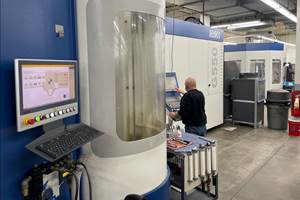Share


Takumi USA
Featured Content
View More


ECi Software Solutions, Inc.
Featured Content
View More



.png;maxWidth=45)
DMG MORI - Cincinnati
Featured Content
View More
Hwacheon Machinery America, Inc.
Featured Content
View MoreWaves of volatility have wracked the manufacturing supply chain for the better part of two years now. While improving, supply chain disruptions still present challenges to our industry. In this article, I examine three major industries to see which supply chain problems they share and to consider a solution.
Aerospace. Commercial airlines were among the first to truly be dealt a blow by the pandemic, but fortunately the way most airlines plan out production needs years in advance buffers against supply chain unpredictability. However well insulated the industry is, supply chain issues are still expected to impact it. The Russia-Ukraine conflict is affecting air travel, oil prices and material delivery at the same time it spurs many countries’ defense sectors to order more aircraft production. Additionally, Ukraine and Russia are both among the top producers of titanium, a critical manufacturing material.
Automotive. As opposed to the aerospace industry, many automotive manufacturers are still straining to meet demand. Even major manufacturers like Toyota, which had ordered huge advance batches of microchips, still struggled to deal with the supply chain issues the microchip shortage and the Suez Canal blockage caused. These days it is not unheard of for a customer to be promised microchip installation after purchase.
Manufacturers that have all the components to produce a full suite of automotive parts are now focusing on reducing cycle time to get cars on the road as fast as possible. General Motors is approaching this by dropping luxury features such as heated seats to focus on the quick production of functional cars.
The Russia-Ukraine conflict is affecting air travel, oil prices and material delivery at the same time it spurs many countries’ defense sectors to order more aircraft production. Photo Credit: Getty Images
Medical. The medical industry has been hit on all sides by the pandemic and the subsequent supply chain failures. According to health care logistics firm Owens & Minor, 45% of medical supplies are in some way supply constrained. The biggest contributors to the medical manufacturing industry’s strain are the lockdowns in China, congested ports and lack of manpower to transport products over land.
Several common stressors become apparent here, including growing geopolitical constraints, some remaining backlogged ports, a shortage of truck drivers and increased cost of transportation due to elevated oil prices. Savvy parts customers will be looking to find more local manufacturers, and those local shops must be ready. Any machine shop, no matter its size, can be successful securing these jobs if they focus on the following:
- Matching (or exceeding) the quality and capabilities of large manufacturers. Fortunately for small shops, advanced manufacturing units are becoming more and more accessible. When bringing in these powerful machines, though, it is imperative to have solid software systems that will pair with the machining centers seamlessly. Shops should look for proven CAD/CAM systems with developers that provide their own postprocessors.
- Improving efficiency at all levels. Prolonged delivery time remains a top concern for companies of all types. That is why finding every opportunity to streamline workflow and boost production speed in the shop is imperative. Common sticking points are lengthy modeling processes, inefficient machining tool paths and inaccurate simulation. A quality CAD/CAM system and simulation software will address these issues.
- Getting the most out of their operator hours. As a large number of the workforce moves out of shops and into retirement, the skilled labor shortage continues to worsen. Setting up and refixturing parts multiple times is a waste of time for experienced employees. Smaller shops should investigate bringing in multi-axis machining, which is becoming more and more financially viable for operations of any size. Multi-axis machining gives shops the ability to take on jobs with tight tolerances and complex geometries because the multi-axis unit’s cutting tool is so much more maneuverable. Jobs that could have taken half a dozen or more setups — and hours of an employee’s time — can be machined in just one setup with multi-axis.
While 2022’s supply chain problems have been a headache, they may bring some good with them: the “in-shoring” of more jobs and the revitalization of local economies.
Mastercam/CNC Software Inc. | mastercam.com
About the Author
Sandy Moffat
With more than 35 years’ experience in the CAD/CAM software industry, Moffat is responsible for sales, marketing, partnerships, education and applications engineering for Mastercam CAD/CAM software.
Related Content
Supercritical Success for Medical Machining
High-pressure carbon dioxide coolant can dramatically improve the production rate of titanium parts while leaving no residue — an excellent fit for medical machining.
Read MoreFive-Axis Turnkey Machine Halves Medical Shop’s Cycle Times
Horizontal five-axis machines cut cycle times in half at ARCH Medical Solutions – Newtown. But its leadership gives equal credit to a surprising factor: the OEM’s service department.
Read MoreAmetek EMC Laser Cutting System Offers Through-Part Cooling
The new laser cutting system offers comprehensive Swiss machining capabilities, as well as through-part cooling and automatic part-handling options.
Read MoreThe Producto Group Appoints New Member to Board of Directors
Dean Schauer, the newest appointee to the company’s board of directors, is the current CEO and president of Confluent Medical Technologies.
Read MoreRead Next
Setting Up the Building Blocks for a Digital Factory
Woodward Inc. spent over a year developing an API to connect machines to its digital factory. Caron Engineering’s MiConnect has cut most of this process while also granting the shop greater access to machine information.
Read More5 Rules of Thumb for Buying CNC Machine Tools
Use these tips to carefully plan your machine tool purchases and to avoid regretting your decision later.
Read MoreBuilding Out a Foundation for Student Machinists
Autodesk and Haas have teamed up to produce an introductory course for students that covers the basics of CAD, CAM and CNC while providing them with a portfolio part.
Read More





.png;maxWidth=150)






































